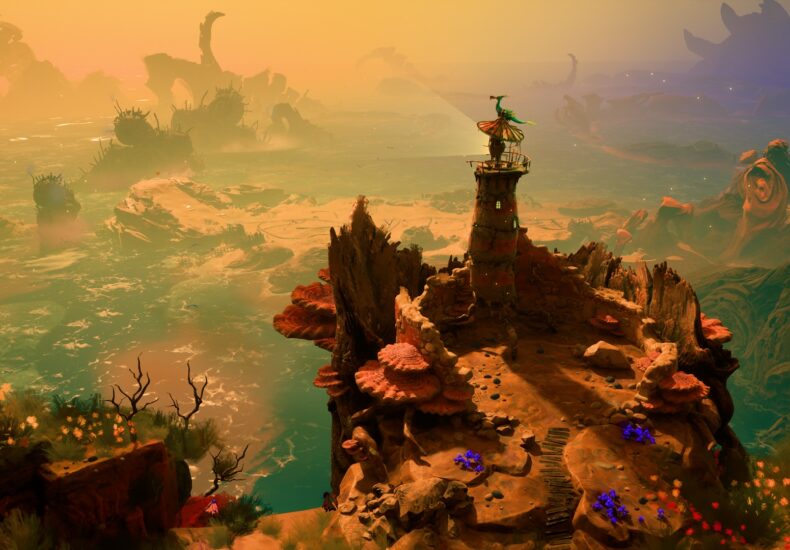
Keeper review: Step into the light
Storybook fables that teach grander lessons about life can come in many different forms. They can be stories about humans or animals with human qualities. They can be tales of friendship, maybe between humans or talking animals. It’s not often, however, that there’s a poignant yarn about a lighthouse and a bird.
The premise of *Keeper*, the latest puzzle-filled adventure game from Double Fine, suggests an oddball, almost wacky kind of friendship story. Yet it ends up being a grander tale of life, time, and nature—one that harbors a surprising amount of emotional depth for a story about a lighthouse.
## Turn on the Light
It’s sometimes difficult to convey what makes a game like *Keeper* such a grand adventure without going into at least some light spoilers. While I’ll try to keep things as vague as possible, it’s not always possible to avoid discussing later sections of the story in more detail. Please keep that in mind as the review progresses.
*Keeper’s* story takes place in a distant future where humans have long since died out. A remote island is being threatened by a dark force known as the Wither. A lighthouse suddenly topples over after years of inactivity, its foundation worn out by the ages. However, it sprouts a pair of legs and begins walking about, having seemingly come to life.
As the lighthouse moves along, a curious bird named Twig flies by and decides to nest atop its peak. The lighthouse can only move forward, and as time passes, Twig helps out in its journey, having developed a strange bond with this seemingly inanimate companion.
A story like *Keeper’s* is one that can easily fall apart if it goes overboard with exposition. There could have been full-blown cutscenes explaining what the Wither is, how long it has existed, or the existential danger it poses. There could have been drawn-out explanations for why the lighthouse is suddenly alive and walking around, or why Twig appeared when she did.
Instead, Double Fine has opted for a minimalistic storytelling approach. There’s no dialogue; story beats unfold through short cutscenes filled with simple actions and gestures. Players are encouraged to use their imagination to determine what’s happening—and more importantly, why it’s happening.
*Keeper’s* subtle narrative approach makes its story resonate that much more.
## A Metaphor for Life
The lighthouse coming alive and everything that happens afterward can be interpreted as a metaphor for life itself. The lighthouse undergoes several phases over the course of the game, starting with its first moments where it’s trying to adjust to its new legs.
As time goes on, age sets in and the lighthouse’s body begins to slowly fall apart. But this decline leads to a new phase with a different purpose. As that purpose is fulfilled, the lighthouse’s body continues to fall apart and transform in new ways—similar to how humans age and change over time.
Without spoiling the ending, it’s a beautiful conclusion meant to make anyone experiencing it reflect on the nature of their own existence and wonder what comes next.
Life and friendship are also conveyed through Twig. Twig begins the game as a curious creature who sees this strange walking tower as a friend, even though it looks nothing like her. As the story progresses, Twig advances through life in her own way—eventually going through various stages with the lighthouse by her side.
Again, without spoiling the ending, Twig’s conclusion is a beautiful one that signifies the end of a personal journey, bringing her fulfillment in a way she never could have expected when it began.
I wasn’t expecting to ponder the nature of life and existence through the view of a lighthouse’s lamp and the perspective of a weird bird. While it’s mainly the beginning and end of *Keeper’s* story that pose greater philosophical questions, the middle portion focuses on elements of nature working together for survival.
Even without the presence of humanity, the life that remains fights to survive and keep the world alive and thriving. A specific section prior to the game’s climax illustrates this idea powerfully, showcasing *Keeper’s* minimalistic storytelling at its best.
## Shining a Spotlight
As part of Double Fine’s narrative approach, there are no explicit objectives throughout the entire length of *Keeper*. Sometimes, that’s for the best. The visual beauty of this natural world and the wonder created by a player’s actions take a big hit when intrusive text interrupts the experience.
At most, objective text will briefly pop up if a player gets stuck at a certain section.
With that said, it isn’t always easy to find which section is the one to focus on. Over the course of my journey, there were several instances where I wandered in circles, unable to find where the next puzzle was located. This was especially true during one of the later sections, which involved cruising around the island’s waterways and circling for several minutes.
*Keeper’s* storytelling largely feeds its gameplay, which makes the former feel that much more fulfilling.
When the story begins, the lighthouse has to adjust to walking on land. Like a baby taking its first steps, it must move carefully or risk toppling over. Since the lighthouse is top-heavy, players have to adjust to the physics to get around.
As the story progresses and the lighthouse takes on new forms, movement gets easier—akin to the transition from childhood to adulthood.
Puzzles often involve using the lighthouse’s bulb to shine its light, bringing life to darkened objects. Directing light at objects can raise platforms or open doors, clearing the way forward. The light can also stave off the darkness of the Wither, which is more of a nuisance than a deadly threat.
*Keeper* has no fail states or death, so there’s no pressure to complete puzzles within a set time. Nor is there reason to worry about the Wither’s darkness covering the lighthouse, though it will slow players down.
Twig also plays a role in puzzles. She’ll retrieve certain objects, help turn cranks, or weigh down switches. The game efficiently uses a sparkling light to indicate where Twig can go, making the most of its on-screen real estate.
One section in particular is worth noting, partly because it’s where I started thinking about *Keeper* as a grander metaphor.
In trying to bring a dilapidated robot back to functionality, the lighthouse must explore three different temples representing the past, present, and future.
– For the past, shining a light on the temple’s symbol turns Twig into an egg, adding extra weight for pressure switches.
– For the future, the symbol turns Twig into a ghost, allowing her to pass through walls.
Manipulating time and the temporal state of the lighthouse’s feathered friend is one of *Keeper’s* most clever puzzle ideas—and this section wraps up far too quickly. I would have loved to see more of this idea in action.
*Keeper’s* other most memorable section comes right at the story’s climax. Without spoiling what happens, it transitions the gameplay from the walking simulator it was at the start, through the boating section in the middle, and suddenly into a Marble Madness-style wild ride down a series of tunnels—where players must use momentum to solve puzzles and clear various areas.
It’s a total blast, doesn’t wear out its welcome, and sets the stage for the story’s powerful ending.
Double Fine makes the most of its settings and wants players to soak in their surroundings at all times. That’s part of the reason there isn’t dedicated camera control.
The camera is used to great effect when entering new areas, often utilizing cinematic corner shots, bird’s-eye views, and shots from beneath the landscape. This creates a beautiful, natural world that’s enhanced by the game’s intentional camera placement.
It’s not always perfect, though—since players don’t have freedom to move the camera, this can sometimes add unnecessary challenge to certain puzzles.
## Friendship Takes on New Forms
*Keeper* is a beautiful story of life and friendship. It’s the kind of story that could be told as an animated feature and still feel powerful, but it’s also one that’s at its best when incorporating puzzle design and narrative pacing that can only be found in a video game.
Double Fine is capable of delivering a myriad of gaming experiences, and *Keeper* somehow manages to stand on its own as something entirely different from anything the developer has released to this point.
If you’re in the mood to think about the nature of the universe, *Keeper* is a story to check out. It’s hard to imagine a living lighthouse bringing out emotion in people, but that’s exactly what makes this game a true keeper.
https://www.shacknews.com/article/146369/keeper-review-score
You may also like
延伸阅读
You may be interested
Globe bets on prepaid fiber, sets expansion
No content was provided to convert. Please provide the text...
Bragging rights up as Samal makes 5150 debut
A stellar Open division field will be shooting for the...
DigiPlus launches P1-M surety bond program
MANILA, Philippines — DigiPlus Interactive Corp. has partnered with Philippine...
 The New York Times
The New York Times
- California Gets Heavy Rain, Snarled Travel and Power Outages for Christmas 2025 年 12 月 25 日 Alexander Nazaryan and Thomas Gibbons-Neff
- $1.817 Billion Powerball Jackpot Won by Single Ticket in Arkansas 2025 年 12 月 25 日 Dan Watson and Rylee Kirk
- Christmas Around the World in Photos 2025 年 12 月 25 日 The New York Times
- Why Russia Is Likely to Reject the New US-Ukrainian Peace Plan 2025 年 12 月 25 日 Ivan Nechepurenko
- No Power, No Heat, No Water: Odesa’s Days of Hell Under Russian Fire 2025 年 12 月 25 日 Kim Barker, Oleksandra Mykolyshyn and Laetitia Vançon
- Prominent Leaders Amplify Disinformation About Brown University Shooting 2025 年 12 月 25 日 Steven Lee Myers
- With Airspace Closed, a Lonely Christmas for Many Venezuelans 2025 年 12 月 25 日 Annie Correal
- Estonia’s Man on Capitol Hill Is on a Charm Offensive 2025 年 12 月 25 日 Adam Sella
- Pope Leo Makes Christmas Call for Dialogue to Address World’s Conflicts 2025 年 12 月 25 日 Motoko Rich
- King Charles Urges ‘Compassion’ and Finding Strength in Diversity in Annual Christmas Message 2025 年 12 月 25 日 Lizzie Dearden



Leave a Reply